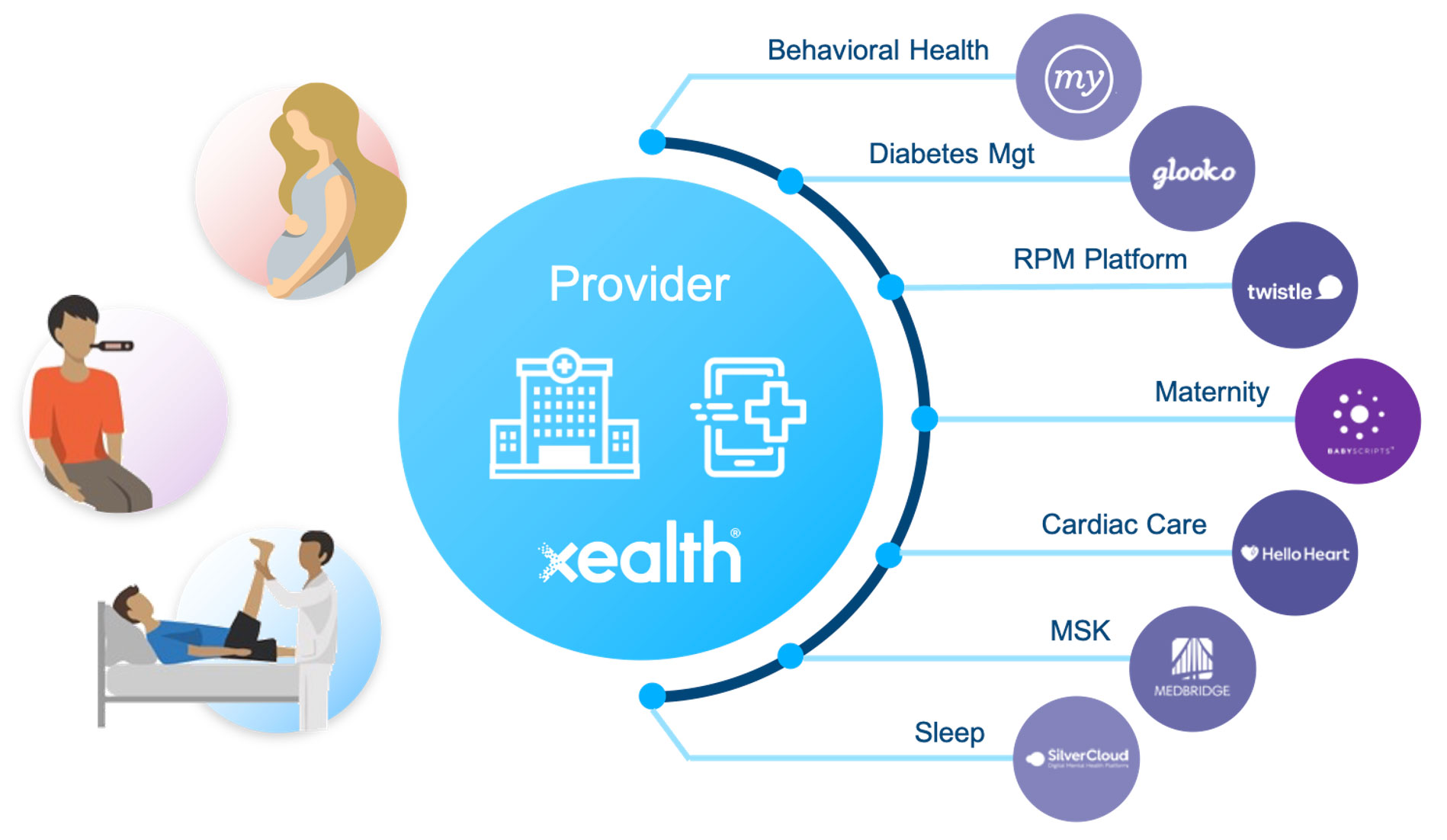Note to readers: This is the sixth post in a six-part series exploring the economics of digital health.
“What’s the ROI?” has become nearly a throwaway phrase meaning, is this program really going to either lead to revenue, or will it save enough time and money to make a difference?
Our final post on the economics of digital health breaks down different ways to measure digital health programs, to make the case that leveraging digital health tools can drive substantial economic benefits.
From Xealth’s experience in boosting revenue-generating activities across dozens of health systems, typical targets for digital health programs include reduced readmissions, lowered no-show rates, enhanced procedure preparation, and increased payor-funded program deployment.
Understanding ROI in Digital Health
Defining ROI in Health Systems
ROI in the context of health systems encompasses the return, and the investment. Starting with the return, these can be both financial and non-financial.
Financial returns include:
- Revenue generation – simply increasing the number of patients who show up for a colonoscopy on time, prepped and ready to go can go directly to the top line
- Reimbursement and incentives – health plans are increasingly partnering with digital health programs with provider partners
- Clinical staff time savings – how many minutes are saved through automating routine activities versus having clinical staff complete tasks?
- Administrative expense reduction – from paper to mailing costs, and the people who stuff envelopes and make phone calls, hundreds of thousands of dollars can be found
Non-financial returns often focus on:
- Patient loyalty – through the portal or not, ensuring the health system is top of mind for all care needs
- Improved patient outcomes – from point solutions to simple communication, evidence consistently supports the premise that digital health supports outcomes
- Patient satisfaction – patients routinely cite convenience of digital health as important to them when choosing facilities
- Standardization of care across facilities – a patient should receive the same level of care in a satellite location as in the main hospital
- Staff satisfaction – apart from saving time, freeing team members to deliver care instead of handling administrative work is a key engagement driver
- Compliance with quality standard – many programs require tracking and documentation; many digital health programs are designed to make this easier
Key Metrics to Measure Return
Determining the return in digital health involves identifying and tracking key performance indicators (KPIs). Although the attribution discussion will likely be lively, especially if there are multiple campaigns running simultaneously, the main metrics remain:
- Reduced readmission rates
- Improved patient satisfaction scores
- Cost-per-patient metrics
In the case where attribution is tricky, Xealth has seen a percentage weighting assigned to a program. In basic terms, the digital health program is credited with achieving only 30-50% of the lift for an improvement in a key area.
Regardless of the final contribution ratio, establishing baseline measurements is crucial for comparing pre- and post-investment performance. Continuous data collection and analysis help assess the impact of digital health investments. Regular reporting and strategy adjustments are essential to maximize ROI and ensure that investments yield the desired outcomes.
How Xealth Makes Measurement Easier
Xealth provides a centralized digital command center which houses centralized reports on all digital health initiatives and programs from all vendors. From this hub, leaders can see the impact of digital health, which is driven by the below activities.
Streamlining Clinical Workflows
Xealth integrates multiple digital tools into a single user interface within the Electronic Health Record (EHR), significantly reducing the time and effort required by clinicians to manage these tools.

This integration enhances efficiency and leads to substantial cost savings, including a 50–80% reduction in IT costs and a savings of 2–3 minutes of staff time.
By streamlining clinical workflows, Xealth helps health systems optimize operations and focus more on patient care.
Enhancing Patient Engagement and Outcomes
Patient engagement is a critical component of achieving better health outcomes.
Xealth’s digital health formulary and patient communication solutions have been instrumental in increasing patient engagement.
For instance, Banner Health integrated SilverCloud into their Digital Therapeutics formulary via Xealth, making it accessible to primary care practices and leading to significant clinical improvements.
Coached users:
- Spend over two hours on average engaging with the platform vs. the 60-minute goal
- Scored an average of 54% on PHQ9 and 58% on GAD7, exceeding the goal of 50%
Reducing Operational Costs
Operational costs are a significant concern for health systems, and Xealth’s centralized integration and streamlined data management provide notable cost savings.
A Medical Group Management Association (MGMA) survey highlighted that no-shows cost healthcare organizations over $150 billion annually. Some estimates show that missed appointments cost single physicians as much as $150,000 annually.
Xealth’s impact is evident in Duke Health’s adoption of distributing educational information to bariatric and cardiothoracic surgery patients, reducing late cancellations and no-shows.
- The bariatric new patient program has a 36% patient interaction rate
- The post-surgery program has a 43% interaction rate
- Patients engaging with educational videos had a no-show rate of 0.71%, compared to 11.5% for those who did not engage.
Dewey, Xealth’s interactive database, empowers health systems to make informed decisions by analyzing metrics such as email or SMS open rates, click-through rates, and completion rates for different use cases. This comprehensive data helps evaluate the performance of digital health initiatives and make necessary adjustments for better outcomes.
Comparisons between different use case performances in the same system, for instance, reveal whether:
- One patient group is more engaged than another
- One type of outreach is more effective than another
- One app performs better than another against segmented patient populations
Facilitating Value-Based Care
Value-based care models focus on delivering better patient outcomes at lower costs. Xealth supports these models by contributing to improved patient outcomes and reduced costs.
For example, Xealth’s role in managing hypertension at Duke Health demonstrates how digital health tools can align with value-based care goals, enhancing both clinical and economic performance.
Duke leveraged Xealth to send educational video bundles annually to over 135,000 patients with hypertension, covering diet changes, high blood pressure effects, and management strategies. Over 80% of engaged patients watched 75–100% of the videos, enhancing patient satisfaction and engagement.
Case Studies and Real-World Examples
Real-world examples highlight the tangible benefits of implementing Xealth.
For instance, Allina Health used Xealth to integrate Medbridge into its EHR, streamlining the creation of home exercise programs (HEP) for physical therapists and saving valuable time. This automation led to nearly 20,000 monitor views by clinicians, resulting in an estimated savings of $120K—$250K and increased patient engagement with their HEPs.
Similarly, Advocate Aurora Health used Xealth to distribute exercise videos to address childhood obesity, allowing patients to complete exercises independently and track progress, supporting their Whole Person Health initiative. The successful video program achieved a 70% open rate and continues to be expanded to other practices.
Future Prospects and Continuous Improvement
The future of digital health holds immense potential for continuous improvement and innovation.
Xealth is committed to enhancing patient engagement, care coordination, and clinician workflows through robust data analytics and thoughtful AI use.
The platform’s comprehensive monitoring and reporting capabilities ensure that health systems can continuously optimize digital health strategies. The long-term economic benefits of adopting a robust digital health strategy include maximized ROI, cost efficiency, improved patient outcomes, increased revenue, enhanced data analytics, and scalability.
We encourage health systems to consider Xealth a strategic partner in their digital health journey. Request a Xealth demo today for a deeper understanding and personalized insights.


